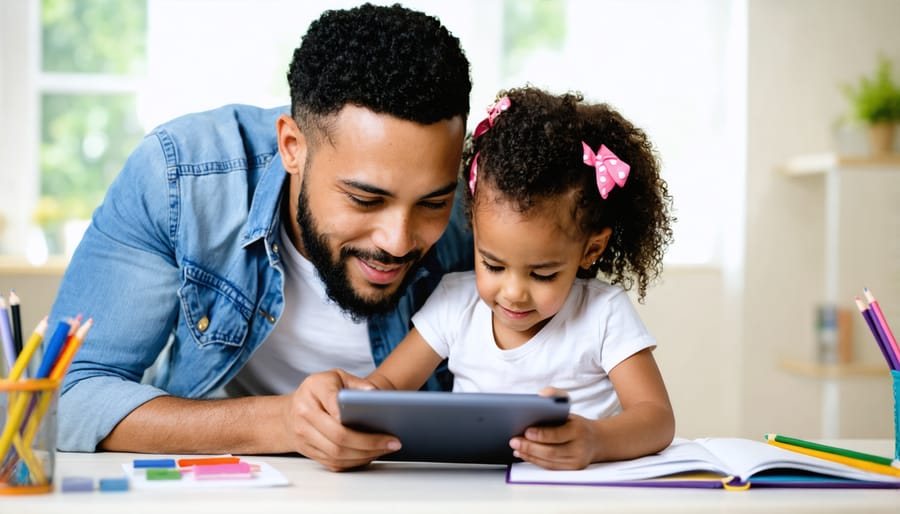In today’s interconnected world, digital citizenship has become as essential as traditional citizenship, shaping how our children navigate, interact, and thrive in the online sphere. Just as we teach our kids to be responsible members of their physical communities, guiding them to become thoughtful digital citizens is crucial for their safety, success, and well-being.
Digital citizenship encompasses the skills, knowledge, and ethical behaviors needed to use technology responsibly and effectively. It’s about more than just knowing how to use devices or social media—it’s understanding how to engage online with respect, protect personal information, think critically about digital content, and contribute positively to the digital world.
For parents and educators, teaching digital citizenship means empowering young people to make informed choices online, recognize potential risks, and harness technology’s benefits while avoiding its pitfalls. As our children spend increasing time in digital spaces, helping them develop these essential skills isn’t optional—it’s a fundamental part of modern parenting and education.
Whether your child is just starting to explore the internet or is already deeply embedded in digital culture, understanding digital citizenship provides the foundation for safe, responsible, and enriching online experiences. Let’s explore what it means to be a good digital citizen and how we can guide our children toward positive digital engagement.
What is Digital Citizenship?
Core Elements of Digital Citizenship
Digital citizenship encompasses five essential elements that help children navigate the digital world safely and responsibly. The first is digital access, which involves understanding and managing how we connect to technology and online resources while ensuring equal opportunities for all.
Digital literacy forms the second core element, teaching children how to find, evaluate, and use online information effectively. This includes developing critical thinking skills to spot misinformation and make informed decisions about digital content.
The third element focuses on digital communication and etiquette, helping children understand how to interact respectfully and safely online. Following proper online safety guidelines and maintaining positive relationships in virtual spaces are crucial aspects of this component.
Digital safety and security make up the fourth element, emphasizing the importance of protecting personal information, creating strong passwords, and understanding privacy settings. This helps children develop healthy boundaries while exploring online spaces.
Finally, digital rights and responsibilities complete the framework, teaching children about their privileges and obligations in the digital world, including respect for intellectual property and standing up against cyberbullying.

Why Digital Citizenship Matters for Children
In today’s interconnected world, digital citizenship plays a crucial role in shaping children’s development and future success. As children spend more time online, their digital interactions significantly impact their social relationships, both online and offline. Positive digital citizenship helps children build meaningful connections, develop empathy, and learn to communicate effectively across different platforms.
The way children engage with digital media directly affects their learning experiences. When children understand responsible digital citizenship, they’re better equipped to use technology for educational purposes, critical thinking, and creative expression. They learn to distinguish reliable information from misinformation and develop essential research skills that benefit their academic journey.
Perhaps most importantly, digital citizenship has a profound effect on children’s mental well-being. Teaching children to navigate the digital world responsibly helps them maintain healthy self-esteem, manage screen time effectively, and protect themselves from cyberbullying and online harassment. As Dr. Sarah Chen, child psychologist, notes, “Children who practice good digital citizenship tend to have more positive online experiences and better overall mental health outcomes.”
By embracing digital citizenship principles, children develop resilience and confidence in their digital interactions while maintaining a balanced approach to technology use.
Building Digital Citizenship Skills at Home

Age-Appropriate Digital Learning
Digital learning needs vary significantly across different age groups, and understanding these distinctions helps create more effective digital citizenship education. For young children (ages 3-7), the focus should be on basic internet safety, supervised screen time, and simple digital etiquette like being kind online. Parents and educators can use interactive stories and games to introduce these concepts in a fun, relatable way.
For elementary school children (ages 8-11), learning can expand to include password safety, basic privacy settings, and responsible content sharing. This age group benefits from guided discussions about digital footprints and the importance of thinking before posting. Role-playing scenarios and group activities can help reinforce these lessons effectively.
Middle school students (ages 12-14) are ready for more complex topics like cyberbullying prevention, social media responsibility, and fact-checking skills. They should learn about digital reputation management and the long-term implications of their online actions. Interactive workshops and peer-led discussions work well at this stage.
High school students (ages 15-18) can tackle advanced concepts including digital privacy rights, content creation ethics, and online citizenship responsibilities. This age group benefits from real-world examples, case studies, and opportunities to create their own digital citizenship projects.
Remember that every child develops differently, so these age guidelines should be flexible and adjusted based on individual maturity levels and digital exposure.
Creating Healthy Digital Habits
In today’s digital world, developing healthy online habits is crucial for both children and adults. Start by managing screen time effectively through clear boundaries and scheduled breaks. Create device-free zones in your home, such as the dining room or bedrooms, to encourage face-to-face interactions and better sleep habits.
Consider implementing the “20-20-20 rule”: every 20 minutes, take a 20-second break to look at something 20 feet away. This simple practice helps reduce eye strain and maintains physical well-being during screen time. Additionally, encourage positive online interactions by modeling respectful communication and teaching children to think before they post.
Dr. Sarah Chen, a child psychologist, suggests, “Set up a family media agreement that outlines expectations for device usage, online behavior, and digital safety. This creates a foundation for open dialogue about technology use.”
Make digital wellness a family priority by:
– Using screen time tracking apps to maintain awareness
– Setting regular “tech breaks” for physical activity
– Creating alternative offline activities
– Practicing mindful device usage
– Establishing consistent bedtime routines without screens
Remember that developing healthy digital habits is a journey, not a destination. Celebrate small victories and adjust strategies as needed to maintain a balanced relationship with technology.
Supporting Digital Citizenship in Schools
Classroom Strategies
Teaching digital citizenship effectively requires hands-on, engaging activities that resonate with students’ daily experiences. One powerful strategy is role-playing scenarios that simulate real digital situations, like responding to cyberbullying or deciding whether to share personal information online.
Create a “Digital Citizenship Corner” in your classroom where students can practice safe online behaviors through guided activities. Include interactive displays about privacy settings, strong passwords, and responsible social media use. Regular class discussions about current digital events help students connect these concepts to real-world situations.
Consider implementing a “Digital Citizenship Ambassador” program where students take turns leading by example and helping peers navigate online challenges. This peer-to-peer approach often proves more effective than traditional top-down instruction.
Project-based learning activities can include creating digital safety posters, developing social media guidelines for the class, or producing short videos about responsible online behavior. These creative projects help students internalize important concepts while developing critical thinking skills.
Regular reflection exercises, such as digital citizenship journals, encourage students to think deeply about their online choices and experiences. Teachers can also use digital citizenship rubrics to help students self-assess their online behavior and set improvement goals.
Remember to celebrate positive digital citizenship moments and create opportunities for students to showcase their understanding through presentations or school-wide digital citizenship campaigns.

Addressing Online Challenges
As our children navigate the digital landscape, they face various challenges that require guidance and support. Common issues include cyberbullying, inappropriate content exposure, digital footprint concerns, and privacy risks. The key to addressing these challenges lies in open communication and proactive education.
Parents and educators play a crucial role in preventing online harassment and fostering positive digital interactions. Start by creating a safe space for children to discuss their online experiences without fear of judgment or punishment. When children feel comfortable sharing their concerns, they’re more likely to seek help when needed.
Dr. Sarah Chen, a child psychologist specializing in digital wellness, suggests implementing a “digital citizenship toolkit” that includes:
– Clear guidelines for online behavior
– Regular check-ins about digital experiences
– Strategies for identifying and reporting inappropriate content
– Tools for managing screen time effectively
– Resources for maintaining digital privacy
“The goal isn’t to restrict children’s digital access,” explains Dr. Chen, “but to empower them with the skills they need to navigate online spaces safely and responsibly.”
Remember that challenges will vary by age group and individual maturity level. Customize your approach based on your child’s specific needs and understanding. By addressing these challenges together, we can help young digital citizens develop resilience and confidence in their online interactions.
As we’ve explored throughout this article, digital citizenship encompasses far more than just online safety – it’s about empowering our children to become responsible, ethical, and mindful participants in our increasingly connected world. By understanding and embracing the core principles of digital citizenship, we can help young people develop the skills they need to navigate online spaces with confidence and compassion.
Remember that digital citizenship education is an ongoing journey, not a destination. As technology continues to evolve, so too must our approach to teaching these essential life skills. Whether you’re a parent, educator, or healthcare professional, your role in guiding children through their digital experiences is crucial to their overall well-being and development.
Take time to regularly discuss digital citizenship with the young people in your care, model positive online behavior, and create open dialogues about their digital experiences. Celebrate their successes when they demonstrate good digital citizenship, and use challenges as learning opportunities rather than sources of criticism.
Together, we can nurture a generation of thoughtful digital citizens who not only understand how to protect themselves online but also know how to contribute positively to the digital world. By maintaining a balanced, empathetic approach to digital citizenship education, we’re investing in our children’s future success in both their online and offline lives.


